
Transit Briefs: CTA, LIRR, Metrolink, Metrolinx, WMATA
Written by Marybeth Luczak, Executive Editor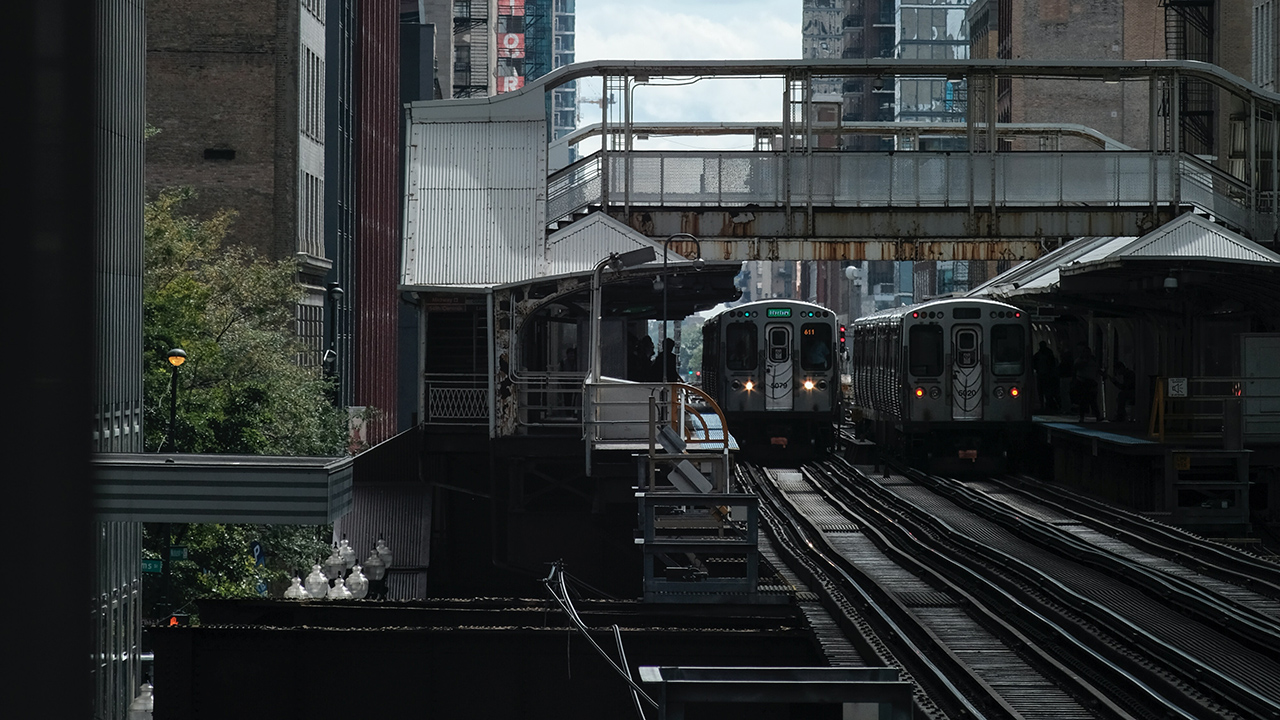
CTA has released a $1.99 billion operating budget proposal for 2024 that reflects a 9.2% (or $168.2 million) increase over the previous year.
Chicago Transit Authority (CTA) proposes a $1.99 billion operating budget for 2024. Also, Rob Free takes over as acting President of MTA Long Island Rail Road (LIRR); Southern California’s Metrolink conducts an on-board drill using earthquake safety technology; WSP in Canada wins a contract for Metrolinx’s Hamilton Light Rail Transit project in Ontario; the Ontario government plans transit-oriented development near six future stations of Metrolinx’s Ontario Line subway and Scarborough Subway extension projects in Toronto; and Washington Metropolitan Area Transit Authority (WMATA) extends Parsons’ task-order contract.
CTA
CTA on Oct. 19 released a $1.99 billion operating budget proposal for 2024 (see above) that reflects a 9.2% (or $168.2 million) increase over the previous year. According to the transit authority, it keeps fares at current levels; maintains the delivery of rail and bus services, with plans for additional service to meet growing ridership demand; includes system upgrade investments; and supports ongoing initiatives for hiring and retaining key operations personnel, while also introducing a new ChatBot for improved customer service, continuing work with Metra, Pace and RTA to offer “innovative” fare products, and developing a new program that will provide pre-loaded Ventra Cards to victims and survivors of domestic abuse.
Federal funding from the American Rescue Plan will help CTA close a projected $473 million budget gap in 2024 and allow the agency to continue providing as much service as possible with its available workforce, said the transit authority, which noted that it “continues to look for ways to operate more efficiently and effectively, and to best serve the region.”
“While more and improved funding and investment is unquestionably the most important issue facing CTA finances, our number one priority is always the people who take hundreds of millions of rides on our system every year,” CTA President Dorval R. Carter Jr. said. “It is incumbent upon us to work diligently to find better ways to serve them and improve their travel experience.” Carter reported that the budget proposal “puts a high premium on providing the highest levels of service, customer comfort, modernization and equity.” He said he is “pleased with the continued progress and positive trends that CTA continues to make, but we still have work to do to provide the service that I believe our customers deserve and expect. I am committed to returning more scheduled service to our bus and rail systems in 2024.”
According to CTA, ridership has grown steadily through 2023, reaching a pandemic-era high of more than 25.83. million rides during the month of September. Overall system-wide ridership for 2023 is forecasted to finish 12% higher than in 2022, and in 2024 it is expected to increase 5.7% over the 2023 forecast.
To continue to improve service delivery, CTA reported that it has surpassed its goal of hiring 700 new bus operators in 2023, and anticipates hiring some 900 more by the end of the year. It said it is also on track to hire approximately 100 bus mechanics this year, which is more than double the normal rate. On the rail side, almost 100 flaggers will have been trained and transitioned into rail operator positions by the end of this year, which CTA said is “significantly more” than historically trained in a year. Overall, CTA is projecting to hire more than 2,000 new employees for the current year, which exceeds the 1,200 annual hiring norm. CTA said it anticipates “continued optimization” of its service schedules to reflect this growing workforce and expects to add additional service in 2024.
According to CTA, the 2024-2028 Capital Improvement Program—which is separate from its operating budget—calls for $3.61 billion in projects over the next five years. Among those projects that will continue or begin in 2024:
- Red Line Extension: CTA’s busiest rail line will be extended to the southern city limits—from the 95th Street Terminal to 130th Street—and include four new accessible stations.
- All Stations Accessibility Program (ASAP): A total of 14 rail stations are now fully funded for future accessibility modernization construction work, CTA reported. Of these, five are currently under construction, three are in design, and five are in various stages of planning. In addition to station improvements, CTA said it has $37 million in funding for elevator replacements and/or upgrades of existing elevators across the system—for up to 16 elevators.
- Rail Fleet Modernization: Increased production of the 7000-series—CTA’s newest generation of railcars from CRRC—and ongoing quarter-life overhauls of the its 5000-series cars.
- Refresh & Renew: CTA will expand this annual facilities improvement program to include more CTA employee workplaces, while continuing to make rail station repairs and improvements.
LIRR
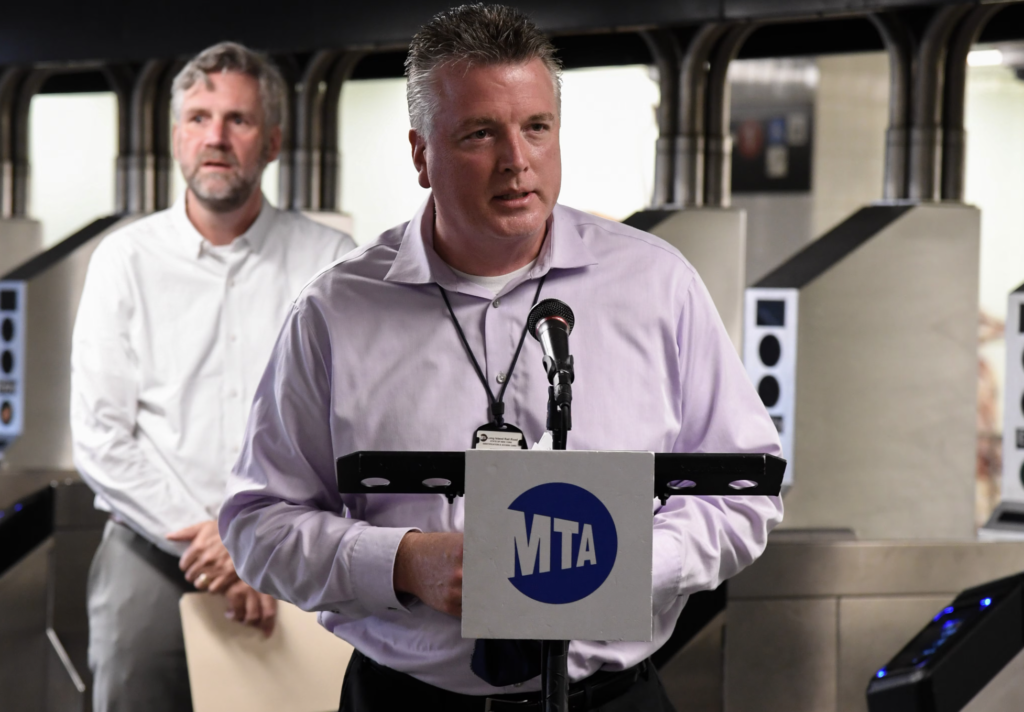
Oct. 19 was Rob Free’s first full day as acting LIRR President. He succeeded Catherine Rinaldi, who in September announced she would transition out of her interim LIRR leadership role, which she took on in 2022 while continuing to serve as MTA Metro-North President.
Rinaldi now heads up Metro-North and holds the Senior Advisor, MTA Railroads position.
Free started working for LIRR 31 years ago as a Station Cleaner and rose through the ranks. He was most recently Senior Vice President, Operations, where he oversaw 7,000 employees in Rolling Stock Maintenance, Train Movement, Maintenance of Way, Service Planning, and Security and Station Operations. He also helped to advance the Main Line Third Track project and the start of service to Grand Central Madison. Prior to this role, Free was LIRR’s Chief Transportation Officer, where he oversaw more than 2,000 employees and was charged with maintaining efficient system-wide train operations and coordinating the many track outages that allowed projects such as Ronkonkoma Branch Double Track and state-of-good-repair maintenance to progress.
“Rob Free has seen and done it all during his long career at the LIRR,” MTA Chair and CEO Janno Lieber said. “A Long Island native, he’s widely respected by his colleagues and a natural choice for acting President. Over the years, he’s led efforts on system safety and customer experience while helping to open critical projects like Grand Central Madison, Main Line Third Track and the first new LIRR station in 50 years at Elmont-UBS Arena.”
As acting President, Free has said he will prioritize safety for customers and employees, reliability, and improving the “customer experience.” He will also oversee the continued recovery of LIRR ridership following the COVID-19 pandemic and any necessary schedule adjustments to adapt to new ridership patterns brought about by the service expansion created when the Main Line Third Track and Grand Central Madison opened earlier this year.
“We have to ensure the safety of our employees and customers while providing a reliable system with consistently improving on-time performance and a strong service plan,” Free said. “I am always looking at ways to improve the customer experience, from planning your trip, by improving the TrainTime app, and making sure train service is meeting our customer’s needs. From the moment you arrive to the moment you depart our facilities I want it to be the best experience possible.”
Metrolink
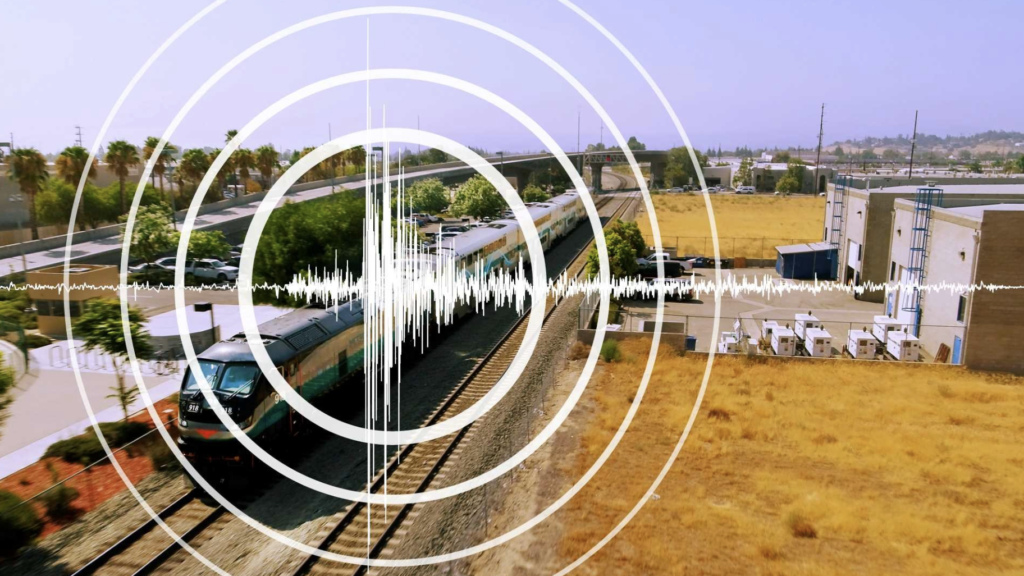
Metrolink on Oct. 19 participated in the annual “Great California ShakeOut,” a state-wide earthquake drill held in conjunction with International ShakeOut Day. Commuter trains operating on Metrolink tracks were automatically slowed via PTC (Positive Train Control) to a restricted speed of or below 20 mph for several minutes before they were released to resume normal operation.
The slowdown was initiated by Metrolink’s early earthquake detection system, which was adopted system-wide in March. According to Metrolink, it is the first and only railroad in the country to integrate PTC and U.S. Geological Survey ShakeAlert early earthquake warning technology. The agency described the technology this way: “Within seconds of earthquake detection, ShakeAlert relays important data, including location, magnitude and anticipated shaking, to Metrolink’s early detection system. Metrolink’s integrated PTC technology then initiates the appropriate automated response to keep impacted trains safe. ShakeAlert also provides enhanced data to help operational staff evaluate the rail network and safely resume service following a disruption.”
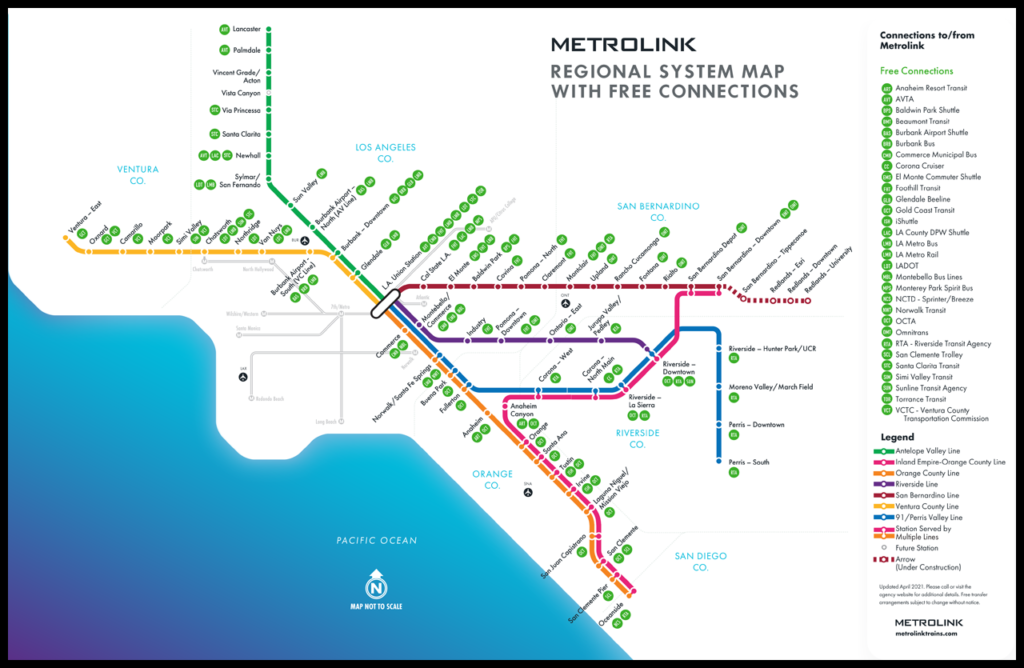
During the drill, conductors on participating trains made an onboard announcement explaining to riders that they were taking part in a simulation and the slowdown was not due to a real earthquake. Metrolink trains traveling on tracks owned by BNSF, North County Transit District and Union Pacific received automated notifications informing crews of the simulated drill.
“In Southern California, earthquakes can happen at any time,” Metrolink CEO Darren Kettle said. “Preparedness is paramount. That’s why Metrolink is setting the bar with a pioneering new early detection system that uses advanced technology to automatically slow or stop our trains in the event of an earthquake. We saw the system in action last August when a magnitude 5.1 earthquake was detected in Ventura County. The Great California ShakeOut is yet another opportunity to showcase this critical tool, while demonstrating our commitment to customer safety.”
Metrolinx
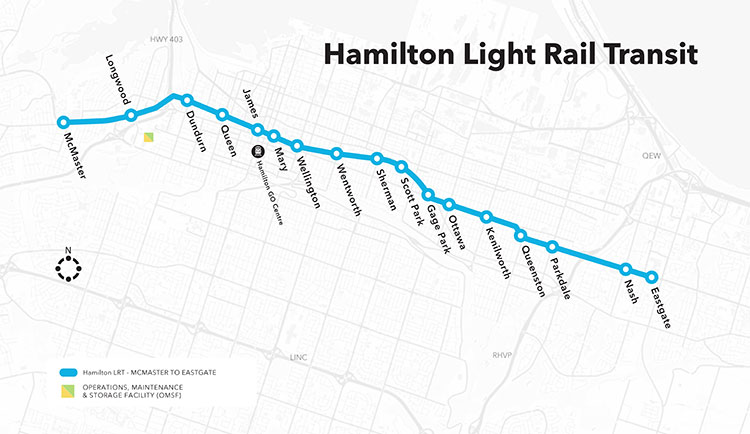
Infrastructure consulting firm AECOM has subcontracted WSP in Canada to provide technical advisory services for Metrolinx’s Hamilton LRT project, a 14-kilometer (8.7-mile) transit line with 17 stops. Metrolinx appointed AECOM to serve as the project’s technical advisor.
WSP in Canada said its rail and transit team will begin providing “strategic guidance” this year on how to best deliver the new line, which will run from Eastgate Square to McMaster University through the downtown core (see map above).
“Our team is proud to be working alongside our partners from AECOM and Metrolinx to help deliver this transformative light rail transit project,” said Jennifer Verellen, Senior Vice President, Transportation Systems at WSP in Canada. “We look forward to using our extensive industry expertise to help deliver the best possible transit system for the people of Hamilton.”
“Hamilton is a thriving community that is undergoing a significant transformation, developing a diverse and prosperous local economy that is driving the city forward,” said Amir Abd El Halim, Executive Vice President, Regional Leader Ontario and the Atlantics for WSP in Canada. “We’re excited to be a part of the development of the new light rail transit system, which will help transform how people connect with places to live, work and play.”
For more on the project’s background, read: “Report: Hamilton LRT Back on Track?”
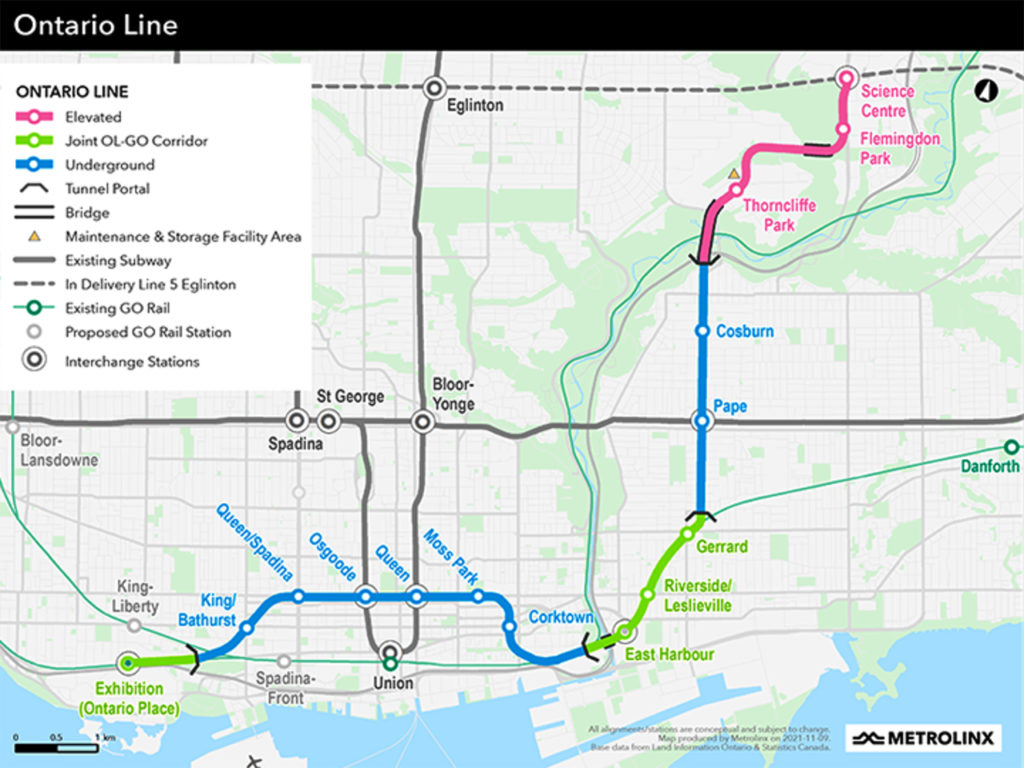
Separately, the Ontario government on Oct. 19 reported its plans to build approximately 5,900 residential units near six future stations of Metrolinx’s Ontario Line subway and Scarborough Subway extension in the greater Toronto area. The proposed transit-oriented communities, it said, will also include affordable housing options while improving access to transit and creating more than 1,900 jobs.
The Ontario Line (see map above) will be a 15.6-kilometer (9.7-mile), 15-station line, running from Exhibition Place, through downtown, and to the Ontario Science Center. Infrastructure Ontario and Metrolinx in April issued Requests for Proposals to six shortlisted consortiums for two major-works contracts: Pape Tunnel and Underground Stations, and Elevated Guideway and Stations.
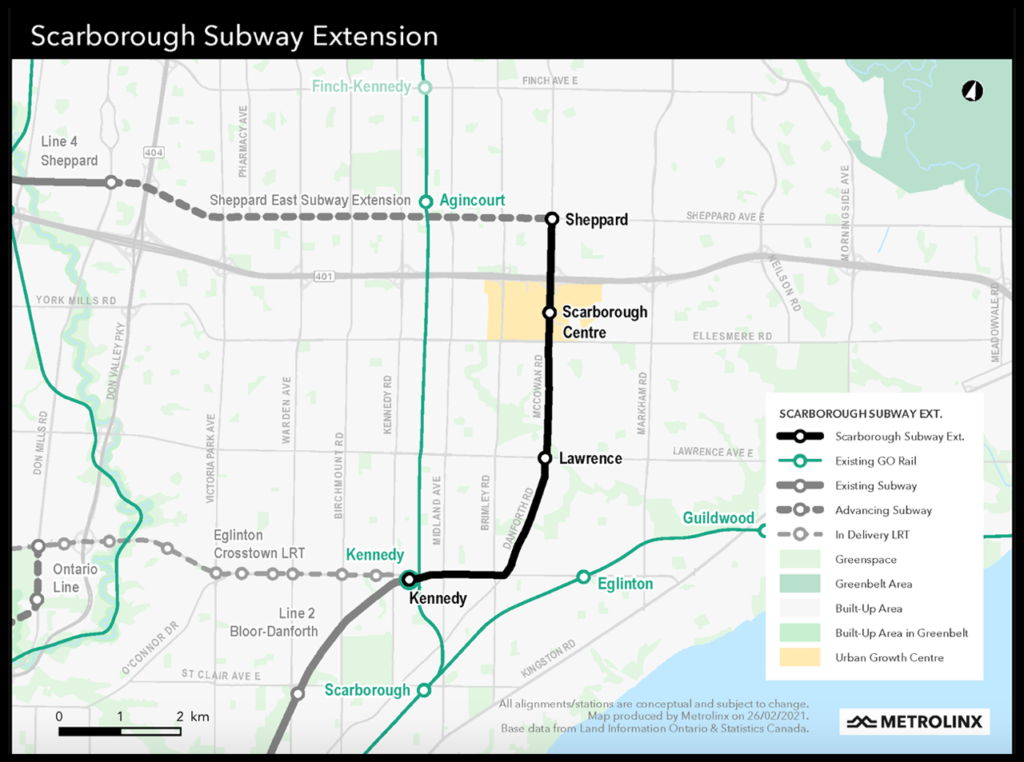
The Scarborough Subway extension (see map above) will bring the Toronto Transit Commission’s Line 2 subway service 7.8 kilometers (4.8 miles) farther into Scarborough and add three stations. It will extend from Kennedy Station to Sheppard Avenue and McCowan Road, and replace Line 3 (the Scarborough RT). In March, the Mace, Comtech and SYSTRA consortium was awarded the Delivery Partner Services contract to support the project.
The province of Ontario is proposing five transit-oriented communities on the Ontario Line, including the Eastern Avenue transit-oriented community, located near the future East Harbor Transit Hub and the Gerrard-Carlaw South, Pape, Cosburn and Thorncliffe Park transit-oriented communities. It is also proposing construction of the first transit-oriented community on the Scarborough Subway extension, close to the Lawrence and McCowan Station.
The city of Toronto is currently reviewing the development proposals. Following this review, the province will engage with the public, stakeholders and Indigenous partners to gather feedback.
“We know the Greater Toronto Area [GTA] needs more housing, and as part of the government’s plan to deliver an expanded transit network, we are seizing a once-in-a-generation opportunity to build vibrant, mixed-use communities that will bring more housing options, jobs, retail and commercial spaces, as well as community amenities, like parks and libraries, close to transit,” said Kinga Surma, Minister of Infrastructure. “These new communities will lower the cost of building infrastructure for taxpayers, while making it faster and easier for everyone to access public transit and everyday conveniences, right in their own neighborhoods.”
“With shovels in the ground on the all-new Ontario Line and Scarborough Subway extension, our government is working at rapid speed to build the largest expansion of public transit in Canadian history,” Ontario Minister of Transportation Prabmeet Singh Sarkaria said. “We’re focused on making life easier for residents and commuters in the GTA, and by building more homes near public transit, we’re delivering on our plan to fight gridlock, create more economic opportunities and support thousands of good-paying jobs.”
WMATA
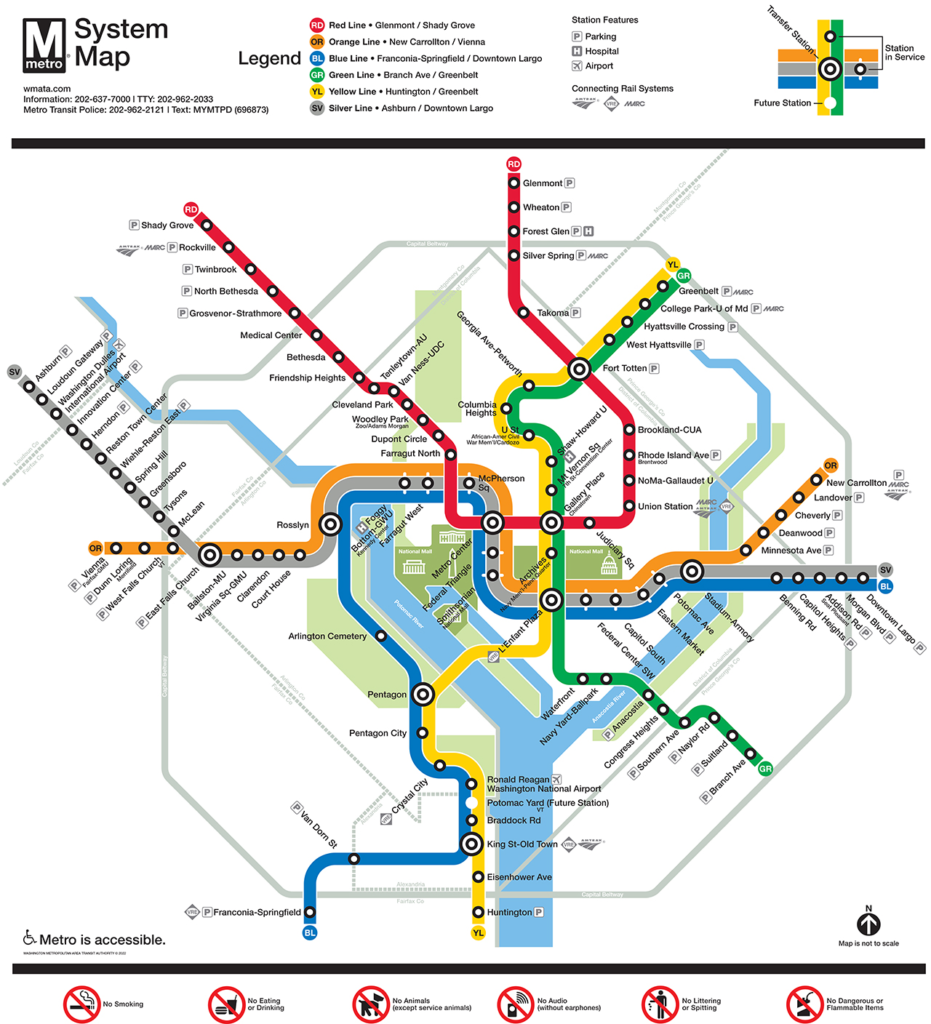
WMATA has awarded Parsons Corporation a $19 million, two-year extension on its task-order contract, the consultancy reported Oct. 19. The new contract will expire May 23, 2025.
The award allows Parsons to continue its Radio Program Project Management and On‐Call Services task order under the WMATA General Architectural and Engineering Consultant Services – Program Management, Construction Management, and Engineering Support Services Indefinite Delivery, Indefinite Quantity Contract. The work includes project management support for the belowground tunnel installation of radio, cellular, and fiber infrastructure; aboveground radio and fiber upgrades; aboveground tower sites for radio infrastructure; and radio equipment installation for both revenue and non-revenue vehicles.
Parsons said it has supported WMATA’s Radio Program since 2017. The multi-year project will replace and upgrade the entire radio infrastructure from T-band frequencies to 700 MHz frequencies, while concurrently installing a cable system through its underground areas for cellular service.
“For over half a century, we have been proud to support Metro [WMATA] in their mission to provide safe and reliable transportation services to the residents and visitors in the National Capital Region,” said Mark Fialkowski, President, Infrastructure North America for Parsons. “Our long-standing relationship with Metro dates back to 1966, when we served as the general engineering consultant for the Metrorail system. We look forward to continuing that partnership as part of this award and to bringing important updates to the Metro system.”



